|
Notes: Beeston Castle & Tarporley was situated on the Grand Junction Railway (GJR) Crewe – Chester line which opened on 1 October 1840. The line was a branch off the GJR main line that ran between Newton Junction (on the Liverpool & Manchester Railway) and Birmingham. Chester was the county town of Cheshire and had been an important administrative and commercial centre for centuries; having a connection to it had been seen as essential by the GJR.

Beeston Castle & Tarporley opened as simply Beeston and was one of the original stations. It was located on the north side of the Tarporley and Whitchurch Road (the present day A49) a mile to the north of its namesake. The station was on two levels as the line was on an embankment at this point. The street level building on the down (Chester direction) platform was an externally rendered L-shaped two-storey villa with a gable projecting towards the forecourt at its south-east end. Window openings were rectangular, with hood moulds. The upper-storey platform elevation carried a flat-topped awning with a fairly deep serrated valance. A flat-topped porte-cochère looked somewhat out of place at the entrance to the relatively modest building. At the rear of the building a subway provided a connection to the platforms via steps. On the platform, immediately north-west of the main building, was a small, pitched-roofed timber building
On the up platform (Crewe direction) there was a single-storey timber building, in a similar style to that on the down, which contained a waiting room. It was provided with an awning to complement that on the opposite platform.
Goods facilities were located at the western end of the station on the south side of the line. They included a single siding and a goods shed on a fairly cramped site between the passenger station and a bridge which carried the line over the A49.
At the time of opening Beeston was served by trains that ran between Chester and Crewe with some through coaches to Birmingham.
 On 8 August 1845 the GJR merged with a number of other companies to form the London & North Western Railway (LNWR). By March 1850 the Crewe – Chester line had been extended from Chester to the important port of Holyhead (by the Chester & Holyhead Railway company, which had opened the line in stages between 1 May 1848 and 18 March 1850. The LNWR took over the line on 1 January 1859 making it part of an important trunk route). Beeston had direct services to London and to Holyhead. The December 1850 timetable showed 8 up and 5 down trains Monday-to-Saturday. On 8 August 1845 the GJR merged with a number of other companies to form the London & North Western Railway (LNWR). By March 1850 the Crewe – Chester line had been extended from Chester to the important port of Holyhead (by the Chester & Holyhead Railway company, which had opened the line in stages between 1 May 1848 and 18 March 1850. The LNWR took over the line on 1 January 1859 making it part of an important trunk route). Beeston had direct services to London and to Holyhead. The December 1850 timetable showed 8 up and 5 down trains Monday-to-Saturday.
On 1 October 1868 the station was renamed Beeston Castle (the castle being located a mile to the south) and just over four years later in January 1873 it was changed again, to Beeston Castle & Tarporley.
By December 1895 Beeston Castle & Tarporley had 9 up and 8 down trains Monday-to-Saturday. On Sundays there were 2 up and 1 down service. The station had direct trains to Chester, Crewe, Holyhead, Llandudno and London Euston.
 By 1898 the station’s goods facilities had been improved. Three new sidings and a larger goods shed were added to the west of the A49 bridge on the south side of the line. The original goods shed was demolished and a cattle dock installed in its place: there was a large cattle market at Beeston. A signal box located on the north side of the line opposite the new goods shed had opened to control movements into and out of the goods yard and along the main line. By 1898 the station’s goods facilities had been improved. Three new sidings and a larger goods shed were added to the west of the A49 bridge on the south side of the line. The original goods shed was demolished and a cattle dock installed in its place: there was a large cattle market at Beeston. A signal box located on the north side of the line opposite the new goods shed had opened to control movements into and out of the goods yard and along the main line.
The July 1922 timetable showed 10 up and 13 down services Monday-to-Friday with an extra up on Saturdays. On Sundays there were 2 up and 1 down train.
On 1 January 1923 Beeston Castle & Tarporley became part of the London Midland & Scottish Railway (LMS). The LMS summer timetable for 1932 showed 20 up and 23 down trains on weekdays. On Sundays there were 3 up and 4 down services.
Passenger services were reduced following the outbreak of the Second World War on 3 September 1939. They had recovered by the summer of 1947, there being 10 up and 14 down services on Monday-to-Friday with extra workings on Saturday. On Sunday there were 6 up and 5 down trains.
Up Trains Summer 1947 |
Destination |
Down Trains Summer 1947 |
Destination |
7.01am |
Crewe |
8.01am |
Chester General |
8.33am |
London Euston |
8.18am |
Birkenhead Woodside |
10.50am |
London Euston |
9.38am |
Holyhead |
12.05pm |
London Euston |
9.45am |
Chester |
12.46pm (Saturdays Only) |
Crewe |
11.24am (Saturdays Only) |
Llandudno |
2.29pm (Saturdays Only) |
Crewe |
11.30am |
Chester General |
3.04pm |
London Euston |
1.17pm (Saturdays Only) |
Chester General |
4.34pm |
London Euston |
2.55pm (Saturdays Excepted) |
Holyhead |
5.41pm |
Crewe |
3.05pm (Saturdays Only) |
Llandudno |
6.08pm |
Birmingham New Street |
3.15pm (Saturdays Only) |
Chester General |
7.49pm |
Crewe |
4.23pm |
Chester General |
9.57pm (Saturdays Excepted) |
Crewe |
5.21pm |
Llandudno |
10.39pm (Saturdays Only) |
Crewe |
6.29pm |
Chester General |
|
|
7.28pm |
Chester General |
|
|
7.53pm |
Llandudno |
|
|
8.59pm |
Holyhead |
|
|
9.58pm |
Rhyl |
|
|
10.41pm |
Chester General |
On 1 January 1948 Beeston Castle & Tarporley became part of British Railways London Midland Region (BR[LMR]).
BR[LMR] services followed a similar pattern to those of the previous owners and by the summer of 1953 there were 9 up trains Monday-to-Friday, 11 on Saturdays and 6 on Sundays. In the down direction there were 11 trains Monday-to-Friday, 12 on Saturdays and 8 on Sundays.
 The Reshaping of British Railways of 1963 (‘Beeching’ report) recommended that all stopping passenger train services between Crewe and Chester General should be withdrawn, which included Beeston Castle & Tarporley. The formal closure proposal was published on 23 April 1964. The winter 1964/5 timetable showed only 9 up and 9 down trains Monday-to-Friday. There were extra trains on Saturdays and on Sundays there were 7 up and 7 down trains almost as good as the service on weekdays. The Reshaping of British Railways of 1963 (‘Beeching’ report) recommended that all stopping passenger train services between Crewe and Chester General should be withdrawn, which included Beeston Castle & Tarporley. The formal closure proposal was published on 23 April 1964. The winter 1964/5 timetable showed only 9 up and 9 down trains Monday-to-Friday. There were extra trains on Saturdays and on Sundays there were 7 up and 7 down trains almost as good as the service on weekdays.
Thomas Fraser, Secretary of State for Transport gave his consent to passenger closure of Beeston Castle & Tarporley and its neighbour Tattenhall Road, on the same line, on 22 October 1965. The goods facilities at Beeston Castle & Tarporley closed on 4 January 1965. The last services ran on Sunday 17 April 1966 and the station closed completely on Monday 18 April 1966.
After closure the station buildings were demolished but the platforms survived and were extant in October 2014.
Tickets from Michael Stewart except horse ticket Andrew Tettenborn
Sources:
- Bradshaws Rail Times March 1850 - Middlewood Press 2012
- Bradshaws Rail Times December 1895 - Middlewood Press 2011
- Bradshaws Rail Times July 1922 - Guild Publishing 1986
- Britains First Trunk Line - Grand Junction Railway - N W Webster, Adams & Dart 1972
- British Railways (London Midland Region) Timetable Summer 1948
- LMS Time Table July 18th to September 11th 1932
- Railway Passenger Stations in Great Britain a Chronology - M Quick - Railway and Canal Historical Society 2009
To see other stations on the
Crewe - Chester line click on the station name: Worleston,
Calverley, Tattenhall,
Waverton 1st &
Waverton 2nd. |

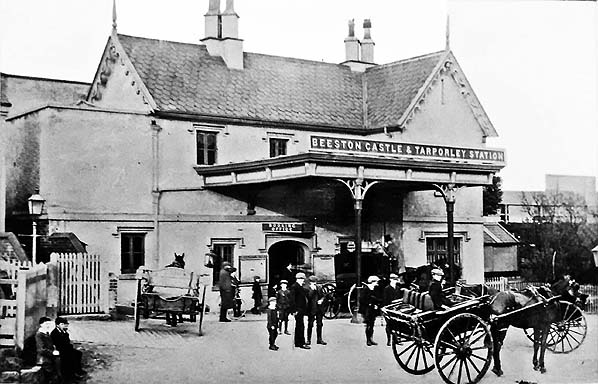
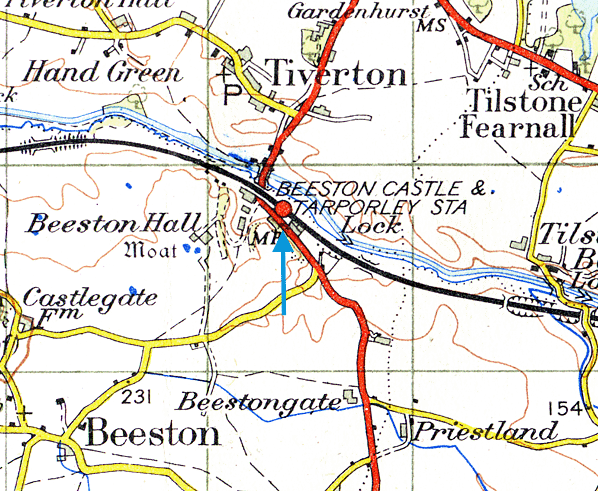
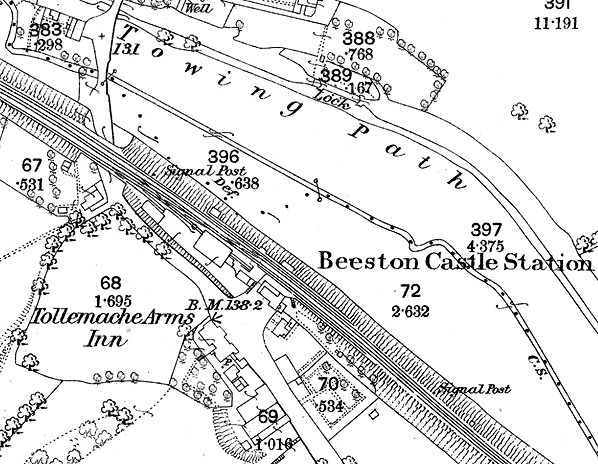
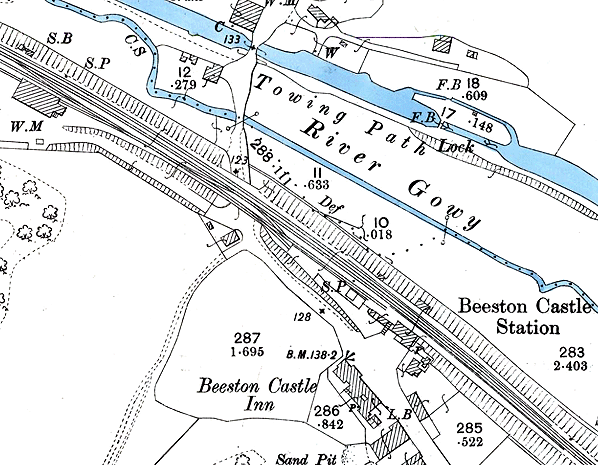
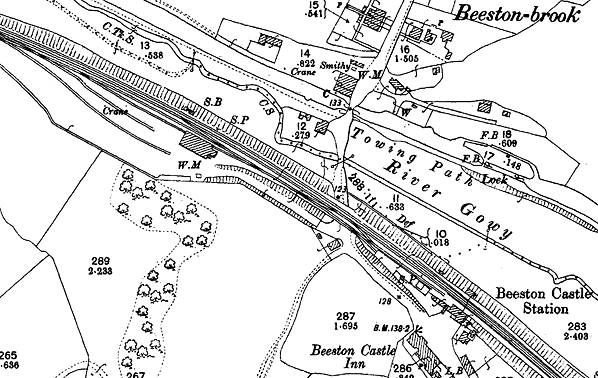
old1.jpg)
old3.jpg)
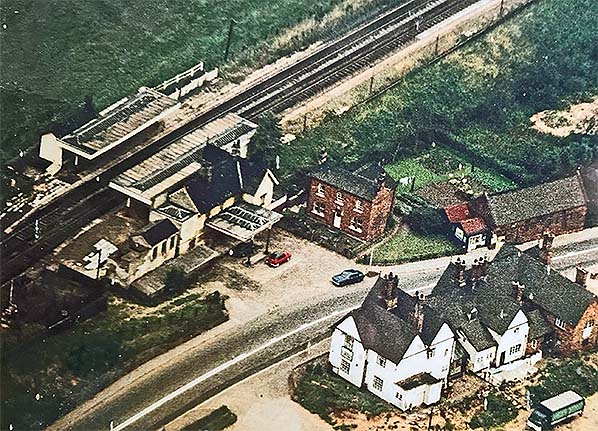
2.jpg)
9.jpg)
 Home
Page
Home
Page

 On 8 August 1845 the GJR merged with a number of other companies to form the London & North Western Railway (LNWR). By March 1850 the Crewe – Chester line had been extended from Chester to the important port of Holyhead (by the Chester & Holyhead Railway company, which had opened the line in stages between 1 May 1848 and 18 March 1850. The LNWR took over the line on 1 January 1859 making it part of an important trunk route). Beeston had direct services to London and to Holyhead. The December 1850 timetable showed 8 up and 5 down trains Monday-to-Saturday.
On 8 August 1845 the GJR merged with a number of other companies to form the London & North Western Railway (LNWR). By March 1850 the Crewe – Chester line had been extended from Chester to the important port of Holyhead (by the Chester & Holyhead Railway company, which had opened the line in stages between 1 May 1848 and 18 March 1850. The LNWR took over the line on 1 January 1859 making it part of an important trunk route). Beeston had direct services to London and to Holyhead. The December 1850 timetable showed 8 up and 5 down trains Monday-to-Saturday.  By 1898 the station’s goods facilities had been improved. Three new sidings and a larger goods shed were added to the west of the A49 bridge on the south side of the line. The original goods shed was demolished and a cattle dock installed in its place: there was a large cattle market at Beeston. A signal box located on the north side of the line opposite the new goods shed had opened to control movements into and out of the goods yard and along the main line.
By 1898 the station’s goods facilities had been improved. Three new sidings and a larger goods shed were added to the west of the A49 bridge on the south side of the line. The original goods shed was demolished and a cattle dock installed in its place: there was a large cattle market at Beeston. A signal box located on the north side of the line opposite the new goods shed had opened to control movements into and out of the goods yard and along the main line. The Reshaping of British Railways of 1963 (‘Beeching’ report) recommended that all stopping passenger train services between Crewe and Chester General should be withdrawn, which included Beeston Castle & Tarporley. The formal closure proposal was published on 23 April 1964. The winter 1964/5 timetable showed only 9 up and 9 down trains Monday-to-Friday. There were extra trains on Saturdays and on Sundays there were 7 up and 7 down trains almost as good as the service on weekdays.
The Reshaping of British Railways of 1963 (‘Beeching’ report) recommended that all stopping passenger train services between Crewe and Chester General should be withdrawn, which included Beeston Castle & Tarporley. The formal closure proposal was published on 23 April 1964. The winter 1964/5 timetable showed only 9 up and 9 down trains Monday-to-Friday. There were extra trains on Saturdays and on Sundays there were 7 up and 7 down trains almost as good as the service on weekdays. 